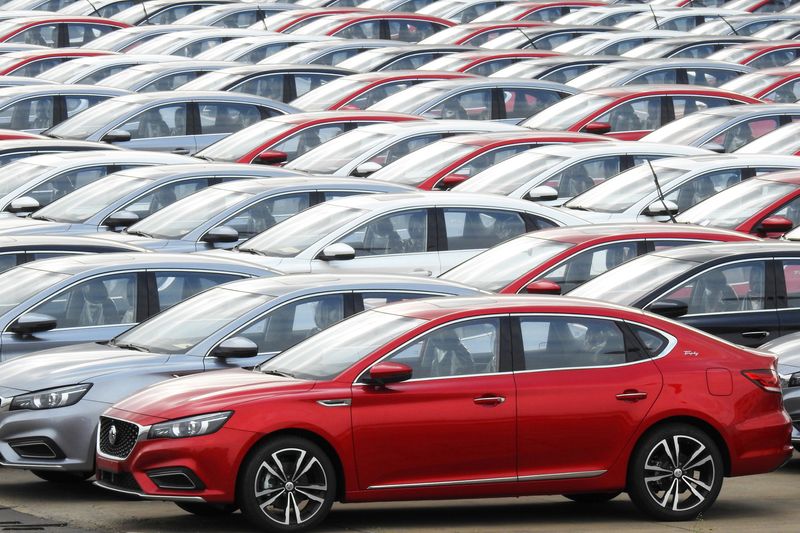By David Lawder
(Reuters) -The Biden administration on Friday locked in steep tariff hikes on Chinese language imports, together with a 100% responsibility on electrical automobiles, to strengthen protections for strategic home industries from China’s state-driven extra manufacturing capability.
The U.S. Commerce Consultant’s mentioned that lots of the tariffs, together with a 100% responsibility on Chinese language EVs, 50% on photo voltaic cells and 25% on metal, aluminum, EV batteries and key minerals, would go into impact on Sept. 27.
The USTR willpower, printed on Friday however first reviewed by Reuters, confirmed a 50% responsibility on Chinese language semiconductors, which now embody two new classes – polysilicon utilized in photo voltaic panels and silicon wafers – are as a result of begin in 2025.
Changes to the punitive “Section 301” tariffs on $18 billion price of products introduced in Could by President Joe Biden had been minimal and disregarded auto trade pleas for decrease tariffs on graphite and significant minerals wanted for EV battery manufacturing as a result of they’re nonetheless too depending on Chinese language provides.
USTR left unchanged the tariff improve to 25% from zero on lithium-ion batteries, minerals and elements, with the rise for batteries for EVs taking impact Sept. 27 and people for all different gadgets, together with laptops and cell telephones, on Jan. 1, 2026.
‘TOUGH, TARGETED’
Lael Brainard, the highest White Home financial adviser, advised Reuters that the choice was made to make sure that the U.S. EV trade diversifies away from China’s dominant provide chain.
She mentioned such “tough, targeted” tariffs are wanted to counteract China’s state-driven subsidies and expertise switch insurance policies which have led to over-investment and extra manufacturing capability. However Washington is investing a whole lot of billions of {dollars} price of its personal tax subsidies to develop home EV, photo voltaic and semiconductor sectors.
“The 100% tariff on electric vehicles here does reflect the very significant unfair cost advantage that Chinese electric vehicles in particular are using to dominate car markets at a breathtaking pace in other parts of the world,” Brainard mentioned. “That’s not going to take place here under the vice president’s and the president’s leadership.”
China has vowed retaliation in opposition to the “bullying” tariff hikes and argued that its EV trade’s success is because of innovation, not authorities help. A spokesperson for China’s embassy in Washington didn’t instantly reply to a request for remark.
The upper U.S. tariffs take impact as Vice President Kamala Harris and former President Donald Trump are each courting voters in auto and metal producing states, attempting to place themselves as robust on China forward of the November presidential election. Trump has vowed to impose 60% tariffs on all Chinese language imports.
The European Union and Canada even have introduced new import tariffs on Chinese language EVs, the latter matching the 100% U.S. duties.
PORT, MEDICAL RELIEF
The ultimate tariff determination does present some momentary reduction for U.S. port operators who had been going through a brand new 25% tariff on huge ship-to-shore cranes, an trade that China dominates with no U.S. producers.
The responsibility would add tens of millions of {dollars} to the price of every crane. USTR mentioned it’s going to permit exclusions from the tariffs for any Chinese language port cranes that had been ordered previous to the Could 14 preliminary tariff bulletins, so long as they’re delivered by Could 14, 2026.
USTR raised tariffs to 50% on medical face masks and surgical gloves, from an initially proposed 25%, however delayed their begin to permit a shift to non-Chinese language suppliers. The deliberate responsibility on Chinese language syringes, which had been briefly provide in the course of the COVID-19 pandemic, will instantly rise to 100% from a beforehand deliberate 50%, however USTR will permit a short lived exclusion for enteral syringes, used to feed infants, for a yr.

The company additionally mentioned it’s going to think about requests for tariff exclusions for 5 Chinese language industrial equipment classes, together with these for equipment for purifying or filtering liquids, industrial robots and printing equipment.
It should permit tariff exclusions for Chinese language photo voltaic wafer and cell manufacturing tools, however not for tools used to make full photo voltaic modules.




